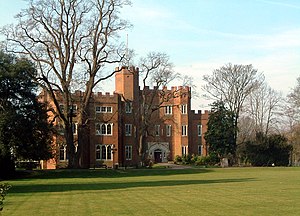Hertford Castle
| Hertford Castle | |
|---|---|
| Part of Hertfordshire | |
| Hertford, England | |

The 16th to 18th-century façade of Hertford Castle.
|
|
| Height | Up to 15 metres (49 ft) |
| Site information | |
| Owner | Hertford Town Council |
| Open to the public |
No |
| Condition | Rebuilt |
| Site history | |
| Built | 911: Anglo-Saxon burgh 1066: Motte-and-bailey 1170 - 1174: Rectangular castle 1540s: Royal Tudor Palace 17th - 20th Century: Private residence |
| Built by |
Edward the Elder William the Conqueror Henry II Henry VIII William Cecil, 2nd Earl of Salisbury |
| In use | Occupied |
Hertford Castle was a Norman castle situated by the River Lea in Hertford, the county town of Hertfordshire, England. Only the gatehouse survives, and is a Grade I listed building.
Hertford Castle was built on a site first fortified by Edward the Elder around 911. By the time of the Norman Invasion in 1066, a motte and bailey were on the site surrounded by a moat. William the Conqueror granted the castle to Peter de Valoignes, the High Sheriff of Essex and Hertfordshire.
Henry II took a great interest in the castle and its potential and it was practically reconstructed between 1170 and 1174. This included the building of the flint walls, drawbridges and gatehouses. The castle was further strengthened during the reign of Richard I by his regent, William Longchamp. By this time the castle was governed by the Crown after Robert de Valoignes had died in 1184 leaving no male heirs. However it had been claimed by Robert Fitzwalter, Robert de Valoignes's son-in-law. He seized the castle and installed his own tenants and garrison. Although he was subsequently evicted by King John, he was eventually appointed governor of the castle. His opposition to the Crown continued and in 1211 he fled to France and the castle was confiscated.
Following the death of Angelo Salvo in 1216, a French invasion besieged the castle for a month until the governor, Walter de Godarvil, surrendered. However the country then supported Henry III and by 1217 the French had left. Following this the castle's military role became secondary to its use as a royal residence and in 1299 Edward I gave it to his second wife Margaret.
...
Wikipedia
